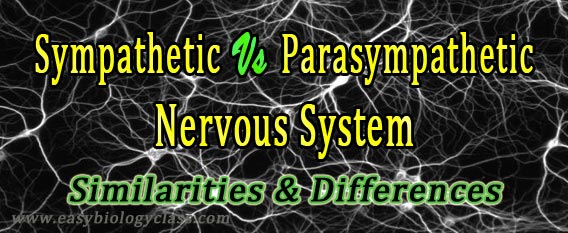Sympathetic vs Parasympathetic Nervous System: The involuntary or reflex functions in the body are controlled by a part of peripheral nervous system called Autonomous Nervous System (ANS). ANS regulate the functions of internal organs (visceral functions) particularly the functions of heart, stomach and intestine. The Autonomic Nervous System composed of two components:
(1). Sympathetic Nervous System (SNS)
(2). Parasympathetic Nervous System (PNS or PSNS)
Sympathetic Nervous System (SNS): They are the part of ANS which originate from the spinal cord of the thoracic and lumbar region. They control the ‘fight-or-flight’ response or the ‘sympatho-adrenal response’ in the body. SNS prime the body for acting in threatening situations for survival. The sympathetic nervous system acts in the body as complementary to the action of Parasympathetic Nervous System.
Parasympathetic Nervous System (PNS or PSNS): Part of ANS originates from the spinal cord and medulla which control the ‘rest-and-digest’ or ‘feed-and-breed’ activities in the body. They act in the body as complementary to the action of SNS.
The present post describes the similarities and differences between Sympathetic Nervous System and Parasympathetic Nervous System
| You may also like NOTES in... | ||
|---|---|---|
| BOTANY | BIOCHEMISTRY | MOL. BIOLOGY |
| ZOOLOGY | MICROBIOLOGY | BIOSTATISTICS |
| ECOLOGY | IMMUNOLOGY | BIOTECHNOLOGY |
| GENETICS | EMBRYOLOGY | PHYSIOLOGY |
| EVOLUTION | BIOPHYSICS | BIOINFORMATICS |
Similarities between Sympathetic and Parasympathetic Nervous System
Ø Both are the part of ANS.
Ø Both originate from the spinal cord.
Ø Both have huge influence on physiological process of the body such as respiration, circulation, digestion, urination and reproduction.
Ø Both have role in maintaining the homoeostasis of the body.
Ø Both composed of pre-ganglionic and post-ganglionic neurons.
Difference between Sympathetic and Parasympathetic Nervous System
Sympathetic Nervous System (SNS) Parasympathetic Nervous System (PNS)
Origin Originated from the cranial, thoracic and lumbar region of the central nervous system Originated from the cranial and sacral region of the central nervous system
Main activity in the body Prepare the body for intense physical activity Relax the body and inhibit high energy functions
Position of ganglion Close to the spinal cord, away from the effector Away from spinal cord, close to effector
Size of pre-ganglionic fibres Short Long
Size of post-ganglionic fibres Long Short
Number of post ganglionic fibres Large numbers Very few numbers
Coverage area of pre-ganglionic fibres Covers a wide are Covers only a restricted area
Mode of effect Show diffused effects in the area of influence Shows localized effects in the area of influence
Transmitter substance Noradrenaline released at the effector Acetylcholine released at the effector
Time of dormancy Dormant during danger Dormant during rest
Control Control reactions to stress Control routine body activates
Homoeostatic effect Excitatory homoeostatic effect Inhibitory homeostatic effect
Effect on blood level Increase Decrease
Effect on metabolic rate Increase Decrease
Effect on heart beat Increase Decease
Effect on sensory awareness Raise sensory awareness Restore sensory awareness to normal level
Effect of pupil Dilate pupils Constrict pupils
Effect on saliva secretion Inhibit saliva secretin Stimulate saliva secretion
Effect on pulmonary system Dilates bronchial tubules Constrict bronchial tubes
Adrenaline release Release adrenaline from adrenal gland Nor action of adrenal gland
Effect on the conversion of glycogen to glucose Increase the rate of glycogen to glucose for muscle power Nor action in the conversion
Effect on urinary output Decrease urinary output Increase urinary output
Effect on rectum Rectum is contracted Rectum is relaxed
<< Back to Human Physiology Lecture Notes

